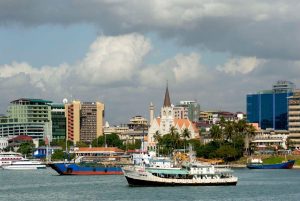Kenya’s new Sh350 million world-class cruise ship terminal will be commissioned next month during the tourist arrivals peak season when luxury ships are expected to dock at Mombasa port.
The terminal is expected to create 300 jobs directly, boosting local industries such as the transport sector, hotels, food providers and curio sellers.
In an interview last week, Tourism and Wildlife Secretary Najib Balala, said the completion of the terminal —which is being constructed using a Sh250 million funding from the Kenya Ports Authority (KPA) and another Sh100 million from Trade Mark East Africa (TMEA) — will give a much-needed lift to the sector’s fortunes.
Industry players are now gearing up for the cruise ship peak season which is set to bring good tidings to the country as the construction of the cruise terminal at the port currently stands at 95 percent complete.
On Sunday, the Port of Mombasa received MS Albatros, the first cruise vessel for the season carrying 446 passengers and 346 crew members. It was sailing from Zanzibar.
While in Mombasa, the tourists toured the city, Maasai Mara, Tsavo National Park and Shimba hills.
The new terminal includes duty -free shops, restaurants, conference facilities and offices for key stakeholders in the industry.
The practical handover expected to take place in the next two weeks. The completion comes in time for the cruise tourism during the festive December period.
“We are pleased to have this call from Ms Albatros; it is the first passenger cruise ship of 2019 docking at the port of Mombasa’s new world class cruise ship terminal. All tourism stakeholders should collaborate on revamping the sector for more luxury ships to call at our port,” said Inchcape Shipping Services, Operations Manager, Mr Bwanaheri Omar Lali.
According to the expert, the modern facility would, position Kenya as a passenger destination through the sea tourism and boost the sector.
The port of Mombasa is one of the busiest ports along the East African coastline providing direct connectivity to over 80 ports worldwide.
“This makes economic logic to have the terminal given that it is a critical node in increasing tourism in the region. The new terminal has modern high-roofed structures whose primary source of energy is solar. Meeting rooms and eateries increase the utility of the terminal. A bio digester that will recycle water for re-use,” a statement from the port stated.
The design of the facility has factored facilities for differently abled people to include special lifts, escalators, conveyor belts, scanners, air conditioning system and washrooms.
KPA Managing Director Daniel Manduku said completion of the terminal will boost tourism in the country.
“The KPA has prioritised cruise ships calling at the port of Mombasa due to the high impact created in the coast region by the arrival of such ships through the facility. The KPA has committed its resources to modernise cruise terminal to meet the international standards,” Mr Manduku said.
On her part, TMEA-Kenya Country Programme Manager Elizabeth Mwangi reiterated the institution’s commitment to support key economic sectors in Kenya.
“Tourism is Kenya’s second-largest source of foreign exchange revenue, holding great potential to create jobs and reduce poverty. In this regard, TMEA-Kenya has marked tourism as a key intervention area. Specifically, in Mombasa, TMEA will roll out an export capability programme on tourism to increase revenues and amplify impact on local economy,” she said.
Mr Manduku said the KPA, Kenya Tourism Board and Ministry of Tourism will undertake extensive marketing abroad to raise the terminal’s appeal as an entry point for tourists to the region and Kenya.
The works on cruise terminal, which began in December 2016, was expected to be completed in August 2017, but was pushed to 2018 then later this year due to “unavoidable circumstances” with Mr Balala blaming the contractor for the delays.
In February, the sector lost estimated 2,000 tourists in cruise ships destined for Mombasa port after they were diverted following the Dusit Hotel terror attacks.



